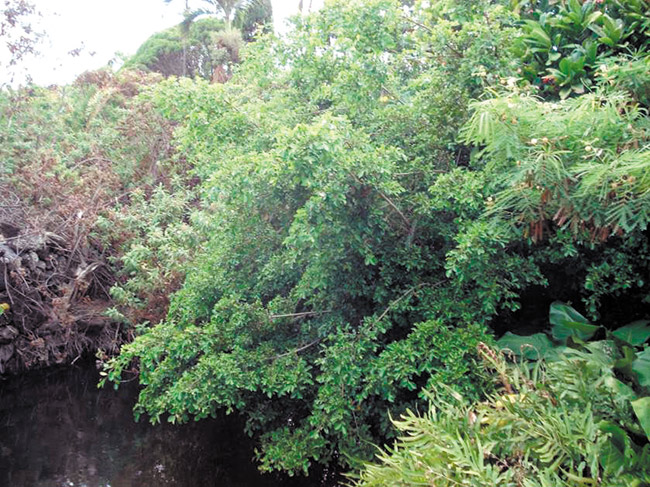Bringing Back Ancient Spring And Fishpond
You’ve heard the saying, “All good things must come to an end.”
Don’t tell that to Chris Cramer and the hardworking volunteers at Maunalua Fishpond Heritage Center. The nonprofit group is committed to bringing ancient Hawaiian fishponds back to life and is being recognized for its efforts.
mw-mizutani-012815-kanewai-spring-before
The center currently is revitalizing Kanewai Spring and nearby Kalauhaihai Fishpond in Niu Valley. The ponds are believed to be some of the last remaining Hawaiian fishponds in Honolulu.
“Kanewai Spring is, as Uncle Henry Chang-Wo puts it, ‘where the mountain gives birth to the sea,'” says Cramer, director of Maunalua Fishpond Heritage Center. “It’s a very sacred place. Picture a fully functioning ancient spring of cold, crystal-clear water. It is even sweet to the taste!”
Cramer paints a vivid and serene picture when he describes the spring.
“The water ripples through an old stone ‘auwai (irrigation ditch system) into an ancient fishpond and out to the Paiko Fishery,” says Cramer. “A historic grove of towering coconut trees surrounds Kanewai Spring. Despite private ownership, it is important that the spring water is properly managed for the public trust and not damaged or destroyed.”
A block away is the group’s other community project at Kalauhaihai, the site of King Kamehameha and Queen Ka‘ahumanu’s former summer home. Area residents say Kalauhaihai was one of the greatest fisheries in Honolulu at one time, pumping an estimated 200,000 gallons of fresh water a day.
Many say the fishpond was damaged during the widening of Kalanianaole Highway some 20 years ago. Soon after, native limu and indigenous fish disappeared and were replaced by invasive algae and tilapia.
“Many folks don’t know it, but this is where Queen Ka‘ahumanu broke the ancient kapu system for the island of Oahu,” adds Cramer.
One of the goals of the center was to bring these ponds back to life. Cramer says in order to that, the organization needed to engage the community in an ongoing stewardship program.
“We started with the kupuna (elders) who used to maintain the ponds,” he says of their initial outreach to community members. “With their help we have worked to pass that expertise to the younger generations.”
Each year, Honolulu League of Women Voters gives the Donald and Astrid Monson Award to an organization or individual who has made an outstanding contribution to or involving public interest planning, housing or environmental issues. This year, the organization recognized the good work of Maunalua Fishpond Heritage Center.
“As you might imagine, we are super appreciative to the league and pleased to have the fishpond work selected,” says an excited Cramer. “Awards such as this really do long-lasting good for the community.”
On Feb. 8, the center will receive the 2014 Monson Award during a ceremony at Paradise Park. The event is open to the public.
Cramer hopes the ceremony will help educate others and revitalize community awareness of the role fishponds played throughout Hawaiian history and their contributions to erosion control and reversing ecological damage.
“With the help of the Trust for Public Land, we have engaged the landowner to purchase this priceless treasure for cultural, educational and conservation purposes,” says Cramer with great pride. “We have had nothing but positive experiences with the landowners who own Kanewai Spring. But we realize there’s tremendous pressure to develop at the site and one of the last of its kind could easily be permanently damaged or destroyed.”
To learn more about fishponds or to support the community effort to conserve Kanewai Spring, visit: facebook.com/MaunaluaFishpond
For more information on the Feb. 8 event, call the league office at 531-7448. rkmizutani@gmai.com






